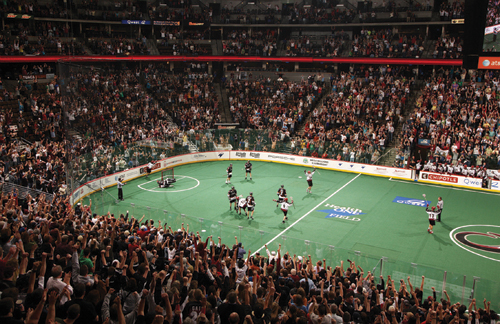If you go to a lacrosse match expecting to see prep-schoolers in sweater vests, khakis and loafers discussing the benefits of exchange-traded funds between goals, think again.
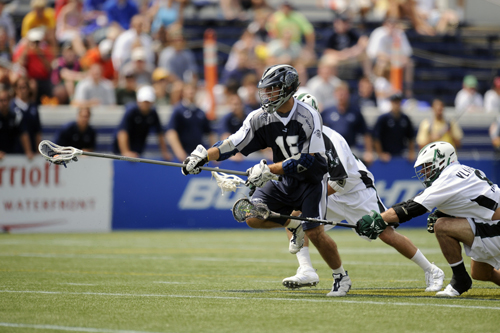 |
GETTY IMAGES
Major League Lacrosse is expanding into Charlotte and Columbus. |
While New England prep schools and Ivy League colleges might have spawned the rapidly growing sport from the Northeast U.S., that crowd represents only a portion of the fan base that's now spending money on the sport. The loafers have given way to Chuck Taylors. The khakis have been replaced by tattered jeans.
"There's kind of this X Games thing that's going on in lacrosse now," said Bill Tierney, a coaching legend who embraced the change around the sport when he left Princeton in 2009 to take the head coaching job at the University of Denver.
Tierney had won six national championships in 22 years at Princeton and built one of the nation's most dominant programs, but he saw Denver as a hip, emerging lacrosse market that could be the launching pad for the sport out West.
"Lacrosse is like this cool new thing to be a part of. It really puts the sport at an interesting place," he said. "And we can be the gateway to the West."
A number of factors are propelling the sport into new markets and broadening the fan base, most notably the support of ESPN, new sponsor interest and two maturing professional leagues, one indoor, the other outdoor.
As the sport attracts new fans by moving beyond its Northeast roots, lacrosse traditionalists now find themselves sharing the sport with a crowd seeking an affordable entertainment option on a Friday night.
A National Lacrosse League game — the indoor version of the sport — "is not what you'd think a lacrosse crowd would be," Tierney said. "It's more like caged wrestling or a big-wheel event.
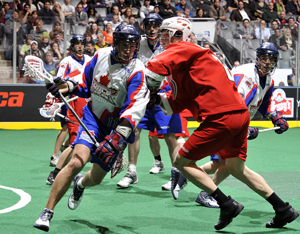 |
NATIONAL LACROSSE LEAGUE (2)
The National Lacrosse League has built an enthusiastic following. Like its outdoor counterpart, Major League Lacrosse, it is looking to expand. |
They want to see somebody get the crap knocked out of them."
The growth by the professional leagues, college programs and overall participation in nontraditional markets such as Denver, Columbus, Ohio, and parts of Texas, California and the Southeast, explains why lacrosse stakeholders believe the sport is elevating out of its niche status and onto bigger stages.
"It's going to be a major league professional sport," said Jim McPhilliamy, a veteran sports marketer and former NBA team executive who is starting a new Major League Lacrosse (the outdoor version) team in Charlotte, where he once was the lead marketer for the Bobcats.
Unlike many stakeholders in the sport, McPhilliamy never played lacrosse. He just saw what he thinks is a sound business opportunity, one he thinks can yield a profit within five years with crowds of 5,000 to 6,000 per game.
"When we look at the MLL in 15 years, we're going to see average crowds of 15,000," he said. "It's going to be worth something."
Can it get there?
The question that many sports marketers come back to is this: Where is lacrosse headed and how big can it get?
"It has a good solid future, but its following is pretty narrow," said Bernie Mullin, president and CEO of The Aspire Group, an Atlanta-based ticketing consultancy. "What you've got to understand is that it's an incredibly crowded sports marketplace in North America, and that restricts lacrosse."
There's no doubting the current popularity of lacrosse. The sport's governing body, US Lacrosse, shows that participation numbers are growing by double digits each year and that the number of active players has doubled in the last eight years.
The sport has much of the rhythm and teamwork of basketball, the full contact of football and, unlike soccer, plenty of scoring. Games move at a brisk pace and typically finish in two hours.
"Will it become a mainstream sport? That's our mission," said Chris Davis, brand manager for Warrior/Brine, which has seen its sales of lacrosse equipment increase for all but one of the 19 years it has been in business.
Whether those participation numbers will manifest themselves into the same wild growth in the professional ranks is another question. The growth from a percentage standpoint is impressive, but it comes from a small, still highly regionalized base, even though it is expanding.
"It's really unfair to compare lacrosse to soccer," said Dale Kohler, senior business unit manager at Warrior/Brine. "Soccer has a longstanding international appeal and hundreds of millions of dollars have been pumped into promoting it domestically with the MLS and World Cup. Lacrosse is more of a challenge."
The interesting dynamic for the pro game is that it feeds off the popularity of the college game and the growing levels of youth participation. By the same token, those involved at the college, high school and youth levels are hoping that the pro leagues can develop the kinds of stars and rivalries that will enhance the sport for the casual fan.
Paul Rabil, a former Johns Hopkins standout who plays in both the MLL and NLL, has emerged as the sport's first real crossover star with endorsements from Red Bull and Under Armour. No one in the sport can remember a player endorsing non-endemic brands before.
Sponsor interest is on the rise for the leagues as well. The NLL, which is celebrating its 25th anniversary, earlier this year hired IMG to cultivate that interest and create a brand strategy.
The MLL has broken through with two of its largest deals this year, a sideline isotonic agreement with Powerade and an exclusive sporting goods retailer partnership with Sports Authority.
The 10-year-old outdoor league hailed the Sports Authority deal as further proof that lacrosse is moving into the mainstream. The retailer will put stand-ups of MLL players in its stores and use the team and league marks in its advertising.
Other sponsors have been around longer. Bud Light has been the official beer since the league launched, while Ford has been on board since 2003.
MLL sponsorships range from the low six figures up to $1 million annually and the league has a broadcast agreement with ESPN for six live games on TV and streaming games on ESPN3. The NLL has an agreement with Versus for seven televised games, with the rest going online.
"It's an opportunity to be a part of something that's growing and right now is still fairly inexpensive for what you get," said David Gross, who is in his eighth year as MLL commissioner. "We also offer partners the chance to own the league. You're not going to run into a situation where Bud is the official beer of the league and Coors is the official beer for a team. The teams sell only the categories that the league hasn't filled."
Expanding footprint
Still, the perception remains that lacrosse can't offer a sponsor a national platform, at least not yet.
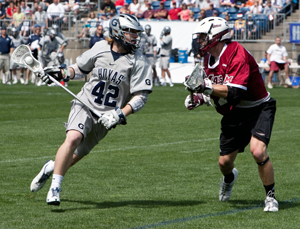 |
MARK GAIER / ESPN
|
| |
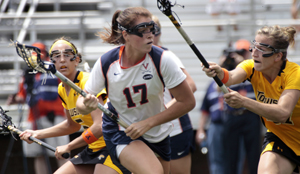 |
GETTY IMAGES
While many universities have been forced to eliminate some sports because of tight budgets, the number of lacrosse programs continues to climb. |
"What's holding back lacrosse is the lack of reach," said Tyson Webber, vice president of client services at GMR Marketing and an avid lacrosse fan who grew up following the sport in Syracuse, N.Y. "The perception of the sport is still that it's mostly off the radar, that it's still very much a niche sport. But it's not the lack of excitement that's holding it back. It's a fast-paced game, it's done in two hours, it's media friendly and it's played in these short, amazingly athletic bursts.
"It's starting to get more attention, but really what it needs to do is define what they are as sport."
Defining lacrosse can be a bit of a challenge. The women's game is different from the men's game. The indoor game (NLL) is different than the outdoor game (MLL).
But what's clear is that no matter the shape it takes, the college and professional ranks are burgeoning with new fans, new markets and new sponsors.
The MLL will add Charlotte and Columbus in 2012 to grow to eight franchises, and plans to add eight more teams over the next decade. During that time, the league hopes to move into markets like Dallas, Orlando, Atlanta and possibly farther west into Salt Lake City, Seattle and Portland.
The NLL intends to move out West as well. One of its most successful teams is in Denver, which averaged more than 15,000 fans this season at the Pepsi Center, and some of the markets in California hold promise, Commissioner George Daniel said.
Turnkey Sports Poll
The following are results of the Turnkey Sports Poll taken in April. The survey covered more than 1,100 senior-level sports industry executives spanning professional and college sports.
 Lacrosse is one of the fastest-growing high school sports. W hen will this growth in youth participation rates result in a popularity boost for the sport's pro leagues — MLL and NLL?
Lacrosse is one of the fastest-growing high school sports. W hen will this growth in youth participation rates result in a popularity boost for the sport's pro leagues — MLL and NLL?
| In the next 2 years | 2% |
| In 3 to 5 years | 16% |
| In 6 to 10 years | 25% |
| More than 10 years from today | 27% |
| Never | 23% |
| Not sure / no response | 7% |
 Which of the following should be the top priority for the pro lacrosse leagues in order to grow their sport?
Which of the following should be the top priority for the pro lacrosse leagues in order to grow their sport?
| Receive more media coverage | 32% |
| Broadcast more games on leading TV networks | 24% |
| Grow attendance | 19% |
| Promote star players/personalities | 12% |
| Expand into more major markets | 3% |
| Add more sponsors | 2% |
| Not sure / no response | 8% |
Source: Turnkey Sports & Entertainment in conjunction with SportsBusiness Journal. Turnkey Intelligence specializes in research, measurement and lead generation for brands and properties. Visit www.turnkeyse.com.
In the college ranks, lacrosse is gaining a stronger foothold in NCAA Division I, even as many colleges are cutting programs. The number of men's lacrosse programs has grown from 56 to 61 in the last five years and two more are slated to begin in 2013. On the women's side, 90 Division I colleges sponsor varsity lacrosse, up from 79 five years ago. Seven more will be added in the next two years.
Nowhere is the growth of lacrosse more evident than at the NCAA championships, which bring the final four Division I teams to one location for the semifinals and finals. Those games draw 40,000 to 50,000 fans on the Saturday and Monday of Memorial Day weekend. When the Division II finals are added to the mix on the Sunday in between, weekend attendance over three days can total nearly 150,000 people.
"There are so many aspects to lacrosse that are compelling," said Greg Shaheen, the NCAA's executive vice president who oversees all 89 championships. "While the roots are in the Northeast, there are clearly growth patterns that show it is developing more of a national following. The question for us is how we grow a true national championship that coincides with the growth around the country."
The NCAA's final four rotates from Baltimore to Foxboro, Mass., to Philadelphia. While the NCAA isn't ready to step outside the markets that have been so good for the sport, it has become a topic of conversation and there is interest in bringing the national championships to Denver.
Other college platforms have evolved, such as tripleheaders in Baltimore and East Rutherford, N.J., run by Inside Lacrosse, which is owned by American City Business Journals, parent company of SportsBusiness Journal/Daily. These one-day events draw 20,000 to 25,000 and are title sponsored by Konica Minolta.
"We want to be where people are passionate about their sport," said Kevin Kern, senior vice president of marketing at Konica Minolta. "It's hard to find a more passionate fan than a lacrosse fan, and when you combine that with the passion of a college fan, you've got a great demographic you're reaching."
Kern understands the sport. He grew up in a small Massachusetts town where "high school lacrosse was bigger than football."
"As the population from the Northeast migrates around the country, this sport is going to keep growing," Kern said. "It's probably more of a niche sport right now, but there are going to be some long-term opportunities there."
Room to grow: Sizing up participation trends in team sports
| SPORT | 2007 | 2008 | 2009 | 2010 | 1-YEAR CHANGE |
| Baseball | 11.57 million | 10.17 million | 9.41 million | 9.70million | +3.1% |
| Basketball | 18.00 million | 17.67 million | 16.45 million | 17.68million | +7.5% |
| Football* | 4.24 million | 4.22 million | 3.68 million | 3.90million | +5.8% |
| Ice hockey | 1.28 million | 1.01 million | 1.19 million | 1.08million | -8.5% |
| Lacrosse | 709,000 | 565,000 | 674,000 | 897,000 | +33.1% |
| Soccer* | 6.37 million | 6.48 million | 6.34 million | 6.59 million | +3.8% |
| Softball (fastpitch)* | 1.33 million | 1.22 million | 1.4 million | 993,000 | -29.1% |
| Volleyball (court)* | 4.06 million | 4.70 million | 3.99 million | 4.12 million | +3.4% |
Note: Players ages 6 and up who competed in the sport 13 or more times in the past 12 months.
* Competed in the sport 26 times or more in the past 12 months.
Source: 2011 SGMA Participation Topline Report
How lacrosse participation breaks down (2010)
| LEVEL | MALE PLAYERS | FEMALE PLAYERS | TOTAL PLAYERS | % 1-YEAR GROWTH |
| Youth | 201,727 | 122,946 | 324,673 | 9.20% |
| Highschool | 149,400 | 105,914 | 255,314 | 2.60% |
| College | 19,326 | 13,105 | 32,431 | 2.60% |
| Professional | 180 | 0 | 180 | 0.00% |
| Post-collegiate | 8,981 | 3,014 | 11,995 | 5.80% |
| Total | 379,614 | 244,979 | 624,593 | 10.00% |
Source: US Lacrosse
Quick facts on lacrosse
- Top five states with the most lacrosse players: Maryland, New York, New Jersey, Massachusetts, Virginia
- This year, 641 women's lacrosse teams and 284 men's teams competed at the collegiate level, compared to 512 women's teams and 226 men's teams in 2007.
Source: US Lacrosse



